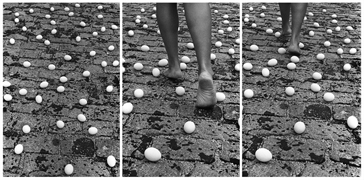
Born in 1942 in Scalea (IT)
Lives and works in Sao Paulo (BR)

1981
Performative installation, eggs, floor
Dimensions variables
éd. de 5 + 2 A.P.
Year of Purchase: 2011
“If you ignore the past, you are jeopardizing the future.” 0
“Creoleness is an annihilation of false universality, of monolingualism, and of purity.” 01
The expression “to walk on eggshells” is a metaphor for “acting cautiously in a delicate situation.” In the ephemeral, performative installation Entrevidas, 1 this saying is literally staring us right in the face in a concrete translation in real space. The ground is covered with 70 dozen chicken eggs, scattered around in an artful disorder over a defined surface, allowing visitors to make their way across. The immediate impression of the body and of the language is correct, but it is also thoroughly incomplete since more than with an installation, we are dealing with a Foucauldian “apparatus” ( dispositif ). 2
Although born in Italy, Anna Maria Maiolino is a Brazilian artist representative of that generation of local avant-garde which emerged from the Anthropophagous Movement. 3 Her status is inseparable from the conceptual and moral essence of her art, and in fact inseparable from its interpretation. Her polymorphous and cross-cutting 4 work addresses the question of the body as a metaphor for continuous invention of life, as a social representation and political responsibility of Brazil, and as a site of feminine subjectivity.
The more ridiculous the means, the clearer their emotional charge; the more salient the empathetic legibility of symbolic opposition, the more striking it is to the imagination. Entrevidas belongs to the category of works representing the threshold of a referential narrative which transfigures them, which engender the desire to confront a reality embodied, not in its own representation, but in the rhythm of life and in culture. Intensely experimental, Entrevidas is inscribed in the present as meditation, by adopting popular symbolism and expression, and represents a machine allowing one to travel back in time, through Brazil and its history. The viewer is a visitor who moves through hyperspace, 5 that is, space which is both heterotopic 6 and heterochronic. 7
The work dates back to 1981, to the heart of the period of the so-called “democratic opening” of the military dictatorship. 8 Reconfiguring the installation today, re-producing the work in the form of an artistic ritual, means restaging the play (and re-examining the evidence) performed in the street in 1981: “An experience of tension and fear. . . . You can construct an analogy between the repression and the menace of the feet and of the dictatorship. In this work, even though we are facing the dilemma of having to choose between life and death, life reaffirms itself vigorously through the symbolism of the egg.” 9
This poetic and sensuous installation turns reality upside down through a critical operation and, through the primitive magic of art, exorcises a system of endemic violence. With its fear of mine fields, Entrevidas is an alienating space, but above all it is a path of embryonic life, a delicate passage towards freedom where the active visitor is projected between two lives. “The past is a broken egg, the future is a hatched egg.” 10
0 Jedi wisdom, The Clone Wars, Season 2, Episode 12: The Mandalore Plot, 2011.
01 Jean Bernabé, Raphaël Confiant, and Patrick Chamoiseau, “In Praise of Creoleness,” 13(4) Callaloo (Autumn, 1990), pp. 886–909, at 892.
1 Entrevidas can be translated as “between two lives” or “in-between lives.”
2 “… a thoroughly heterogenous ensemble consisting of discourses, institutions, architectural forms, regulatory decisions, laws, administrative measures, scientific statements, philosophical, moral and philanthropic propositions—in short, the said as much as the unsaid. . . . The apparatus itself is the system of relations that can be established between these elements.”
Michel Foucault, What is the dispositif ?, 1977
“I shall call an apparatus literally anything that has in some way the capacity to capture, orient, determine, intercept, model, control, or secure the gestures, behaviors, opinions, or discourses of living beings.”
Giorgio Agamben, What is an apparatus ?, 2007
3 The Anthropophagous Movement aims to examine the question of Brazil’s cultural dependence by defining a modern Brazilian identity caught between two cultures: the primitive culture (Amerindian and African) and Latin culture (the European cultural heritage); by overcoming the violent character of their opposition in order to “construct the anthropophagic ideal” through an ideological process of assimilation akin to the hybridization in the Creoleness—a Brazilianness made hybrid through the economy of digestion.
4 Performances, photographs, films, installations, paintings, sculptures, drawings, engravings, publications…
5 Hyperspace is a sort of hyperlink applied to physical space.
6 Michel Foucault, Of Other Spaces, 1967
7 Concordance of distinct and distant temporalities.
8 The dictatorship was in power in Brazil from 1964 to 1985. The period of transition to democracy began in 1979 with the enactment of the amnesty law. The law, which was fought for by the people who demanded freedom for political prisoners and the return of dissidents exiled by the emergency regime, ends up being a deviant compromise in which the military authorities grant amnesty both to their opposition and to themselves. The process of national reconciliation thus bars the possibility of any investigation into the crimes committed under the dictatorship. Everything is pardoned; there are no guilty or responsible parties; the common interest lies in the tabula rasa.
9 Anna Maria Maiolino.
10 Paul Eluard, Les Sentiers et les routes de la poésie, 1974
Luc Jeand’heur